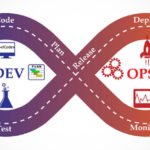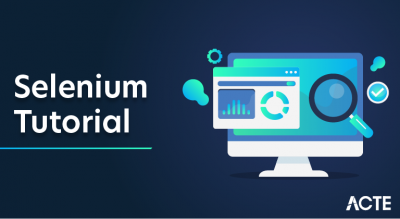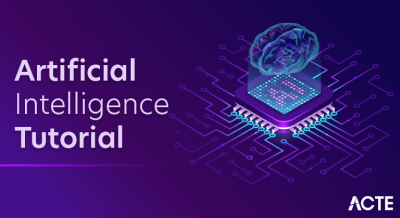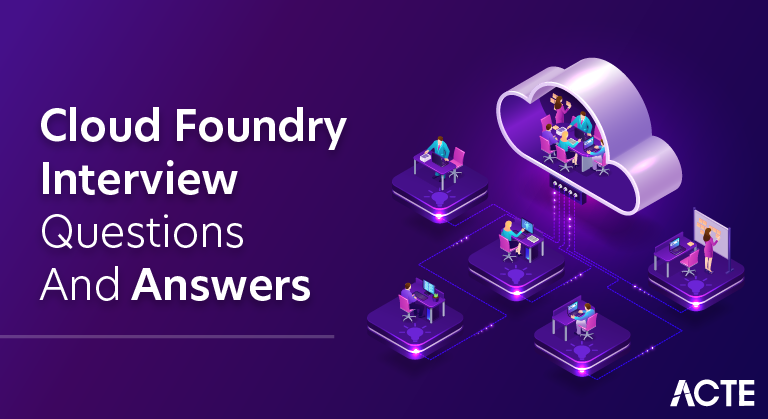
Cloud Foundry has become the industry standard today. It’s an open source platform that you can run your applications on your own computing infrastructure, or deploy on an IaaS like AWS, vSphere, or OpenStack. Cloud Foundry is an open source cloud computing PaaS. … Cloud Foundry was primarily written in Ruby and Go.
1) What is the Cloud Foundry?
Ans:
Cloud Foundry is an open source cloud computing platform originally developed in-house at VMware. It is now owned by Pivotal Software, which is a joint venture made up of VMware, EMC, and General Electric.
2) Why do we need Cloud Foundry?
Ans:
Cloud Foundry (CF) has become the industry standard. It is an open source platform that you can deploy to run your apps on your own computing infrastructure, or deploy on an IaaS like AWS, vSphere, or OpenStack. You can also use a PaaS deployed by a commercial CF cloud provider.
3) What is a Buildpack?
Ans:
- Buildpack is a core link in the chain of the Cloud Foundry deployment process. It automates detection of an application framework, application compilation and running.
- Being a happy user of Cloud Foundry for a long time, I haven’t had any troubles while using the official build packs for Ruby, Java, and Python projects.
4) What is the use of Cloud Foundry?
Ans:
Cloud Foundry is an open source cloud platform as a service (PaaS) on which developers can build, deploy, run and scale applications.
5) Is Cloud Foundry a PAAS?
Ans:
Cloud Foundry is an open source, multi-cloud application platform as a service (PaaS) governed by the Cloud Foundry Foundation, a 501(c)(6) organization.
6) What is Cloud Foundry’s container-based architecture?
Ans:
Cloud Foundry’s container-based architecture runs apps in any programming language over a variety of cloud service providers. This multi-cloud environment allows developers to leverage the cloud platform that suits specific app workloads and move those workloads as necessary within minutes with no changes to the app.
7) What is Open Service Broker API?
Ans:
Applications deployed to Cloud Foundry access external resources via a Open Service Broker API.
8) What are services in Cloud Foundry?
Ans:
In a Cloud Foundry platform, all external dependencies such as databases, messaging systems, files systems and so on are considered Services.
9) What is Pivotal Cloud Foundry?
Ans:
Cloud Foundry is an open source cloud computing platform originally developed in-house at VMware. It is a platform (PaaS) for cloud native application, it helps developer to just focus on code rather worrying about platform they use and their configurations.
10)What are the advantages of Pivotal Cloud Foundry(PCF)?
Ans:
The advantages of using Pivotal Cloud Foundry(PCF) are as follows-
- Fast application development and deployment.
- Highly scalable and available architecture.
- DevOps-friendly workflows.
- Reduced chance of human error.
- Multi-tenant compute efficiencies.
11)What is Cloud Foundry BuildPack?
Ans:
- Build packs provide framework and runtime support for apps. Build packs typically examine your apps to determine what dependencies to download and how to configure the apps to communicate with bound services.
- When you push an app, Cloud Foundry automatically detects an appropriate build pack for it. This build pack is used to compile or prepare your app for launch.
12) What is CLI? How to use it?
Ans:
- The Cloud Foundry (cf) command line interface (CLI) provides a set of commands for managing your apps. We will need to download and install this interface for our windows machine.
- Download the CF Windows installer. It will prompt for the download. Save the zip file distribution.
- To list all of the cf commands and associated help information, use cf help. Use cf command_name -h to view detailed help information for a particular command.
13)How to deploy Spring Boot Application to PCF?
Ans:
Deploying Spring Boot Application to PCF
14) How to deploy Spring Boot + MySQL Application to PCF?
Ans:
Pivotal Cloud Foundry Tutorial – Deploying Spring Boot + MySQL
15) How to deploy Spring Boot + RabbitMQ Application to PCF?
Ans:
Pivotal Cloud Foundry Tutorial – Deploying Spring Boot + RabbitMQ
16)What are various Roles and associated permissions in PCF?
Ans:
| Role | Permissions |
|---|---|
| Admin | An admin user has permissions on all orgs and spaces |
| Admin Read-Only | This role has read-only access to all Cloud Controller API resources. |
| Global Auditor | This role has read-only access to all Cloud Controller API resources except for secrets such as environment variables. |
| Org Managers | managers or other users who need to administer the org |
| Org Auditors | view but cannot edit user information and org quota usage information |
| Org Billing Managers | create and manage billing account and payment information |
| Org Users | Can view the list of other org users and their roles. When an Org Manager gives a person an Org or Space role, that person automatically receives Org User status in that Org |
| Space Managers | Managers or other users who administer a space within an org |
| Space Developers | Application developers or other users who manage applications and services in a space |
| Space Auditors | View but cannot edit the space |
17) What is difference between IaaS vs PaaS?
Ans:
- PaaS, or solution stack, offers a more comprehensive approach to the cost effective application deployment need of today’s developers. This service provides the necessary hardware architecture and software framework needed to put an application into service, without having to own, manage and upkeep all the required resources.
- IaaS, in comparison to the PaaS, provides equipment for operations, networking, data storage and hardware with the use of the internet, so that the subscriber is no longer confronted with location and purchase costs.
- On-premises IT infrastructure is like owning a car. We have to take full responsibility for its upkeep. If needs to use latest car we will need to but new one then.
- IaaS is like renting a car. When you rent a car, we choose which ever car we want and then drive to our destination ourselves. If we need latest car we then rent another car
- PaaS is like taking a taxi. We dont need to drive it. We just tell the driver the destination and he drives us around while we relax

After successfully unzip operation, double click on the CF CLI executable. Install this executable-
18) Where resources are stored in Cloud Foundry?
Ans:
A Git system is there in Cloud foundry that is used on github for controlling simply the buldpacks, source code, important documentation as well as other resources. It is also possible that developers use github for custom configurations. Large binary files like droplets are stored in internal or external blobstore which is maintained by the Cloud Foundry. When it comes to sharing or storing the information which is temporary, Consul and MYSQL is being considered by Cloud Foundry.
19)What is BOSH in Cloud Foundry?
Ans:
BOSH creates and deploys virtual machines (VMs) on top of a physical computing infrastructure, and deploys and runs Cloud Foundry on top of this cloud.
20)What is the Cloud Controller?
Ans:
The CF Cloud Controller runs the apps and other processes on the cloud’s VMs, balancing demand and managing app lifecycles.
21) What is the router?
Ans:
The router routes incoming traffic from the world to the VMs that are running the apps that the traffic demands, usually working with a customer-provided load balancer.
22)What is User Authentication and Authorization in CF?
Ans:
CF manages user accounts through two User Authentication and Authorization (UAA) servers, which support access control as OAuth2 services and can store user information internally, or connect to external user stores through LDAP or SAML.
23)Where CF Stores Resources?
Ans:
Cloud Foundry uses the git system on GitHub to version-control source code, build packs, documentation, and other resources.
24) What is OAuth2 Server (UAA) and Login Server?
Ans:
The OAuth2 server (the UAA) and Login Server work together to provide identity management.
25)What are the platforms that are used for the large scale Cloud Foundry?
Ans:
There are two common platforms that are considered when it comes to large scale Cloud Foundry and they are MapReduce and Apache Hadoop. Both of them are compatible and best in doing their task.
26)List out the components of Cloud Foundry?
Ans:
The list of Cloud Foundry components:
- Cloud Foundry Components
- Routing – Router
- Authentication – OAuth2 Server (UAA) and Login Server
- App Lifecycle – Cloud Controller and Diego Brain, nsync, BBS, and Cell Reps
- App Storage and Execution – Blobstore, Diego Cell
- Services – Service Brokers
- Messaging – Consul and BBS
- Metrics and Logging – Loggregator
27)Cloud Controller maintains which records?
Ans:
The Cloud Controller also maintain records of orgs, spaces, user roles, services, and more.
28) What are nsync, BBS, and Cell Reps?
Ans:
- To keep applications available, cloud deployments must constantly monitor their states and reconcile them with their expected states, starting and stopping processes as required.
- The nsync, BBS, and Cell Rep components work together along a chain to keep apps running. At one end is the user. At the other end are the instances of applications running on widely-distributed VMs, which may crash or become unavailable.
29)How the nsync, BBS, and Cell Rep components work together?
Ans:
- nsync receives a message from the Cloud Controller when the user scales an app. It writes the number of instances into a DesiredLRP structure in the Diego BBS database.
- BBS uses its convergence process to monitor the DesiredLRP and ActualLRP values. It launches or kills application instances as appropriate to ensure the ActualLRP count matches the DesiredLRP count.
- Cell Rep monitors the containers and provides the ActualLRP value.
30)What is Blobstore?
Ans:
The blobstore is a repository for large binary files, which Github cannot easily manage because Github is designed for code. The blobstore contains the following:
- Application code packages
- Buildpacks
- Droplets
31) What is Diego Cell?
Ans:
Application instances, application tasks, and staging tasks all run as Garden containers on the Diego Cell VMs. The Diego cell rep component manages the lifecycle of those containers and the processes running in them, reports their status to the Diego BBS, and emits their logs and metrics to Loggregator.
32) What are Service Brokers?
Ans:
Applications typically depend on services such as databases or third-party SaaS providers. When a developer provisions and binds a service to an application, the service broker for that service is responsible for providing the service instance.
33)What are Consul and BBS?
Ans:
- Cloud Foundry component VMs communicate with each other internally through HTTP and HTTPS protocols, sharing temporary messages and data stored in two locations:
- A Consul server stores longer-lived control data, such as component IP addresses and distributed locks that prevent components from duplicating actions.
- Diego’s Bulletin Board System (BBS) stores more frequently updated and disposable data such as cell and application status, unallocated work, and heartbeat messages. The BBS stores data in MySQL, using the Go MySQL Driver.
34)What is Loggregator?
Ans:
The Loggregator (log aggregator) system streams application logs to developers.
Ans:
- Distributed applications accessible over network.
- Resource on Demand : On-demand cloud computing allow provide resources on an “as needed” basis to client, rather than all at once. Advantages are Efficient Resources Management, Reduced Costs etc.
- Can run in-house (private cloud) as well.
- Hardware and Software sold as commodity
- Inherently Virtualized : Because of this feature, there are many benefits like Cost reduction, Clean up the environment.,Uptime increase,Faster provisioning, Easier backup.
Ans:
Iaas (Infrastructure as a Service)
- Replacement for physical hardware
- Provides virtual hardware , OS, Network
- Amazon Web Services (AWS), RackSpace, Microsoft Azure, VMware vCloudAir
PaaS (Platform as a Service)
- More than a raw machine with OS
- Provides ready-made Platform for running apps
- CloudFoundry, Heroku, Google App Engine, Amazon Elastic Beanstalk
SaaS (Software as a Service)
- Complete Software Application
- SaleForce.com, Google Apps etc.

Ans:
- Open Source : Reduce vendor lock
- Public OR Private
- Language Independence ‐ Via Buildpacks
- Wide growing range of services
Ans:
Cloud Foundry is an open source cloud PaaS(Plateform as a Service), It can be deployed on any IaaS (Infrastructure as a Service), like OpenStack, AWS, vSphere. Below is high level cloud foundry architecture and it’s major components.

- Router: A unique route exist for each application. Cloud Foundry uses this router to map incoming request to the right application.
http://techgeeknext.cfapps.io - Blobstore: Storage for droplets and binary large files. Eliminates the need to reupload/restage when scaling application. NFS mounted storage or Amazon S3 store
- Cloud Controller Database (CCDB): Storage for application metadata.
Sore information like Application Name, No of instances, Memory limits, application Routes, Bound services ( like MYSQL,RabbitMQ)
A postgres DB instance - OAuth2 Server (UAA) and Login Server: User Authorization And Authentication (UAA), provides identity, security and authorization services.
- nsync, Cell Reps,BBS : The nsync, BBS, and Cell Rep components work together along a chain to keep apps running. At one end is the user. At the other end are the instances of applications running on widely-distributed VMs, which may crash or become unavailable.
- Auctioner: Gather states from appropriate sources of truth at decision time , run the algorithm, tell the cell that wins the auction by placing the action on BBS
- Cloud Controller and Diego Brain: Cloud Controller provide restful interface to domain object, it response to client like CLI, WEB UI, Spring STS
- Diego Cell :Diego is a self healing container system that attempts to keep the correct number of instances running in Diego cells to avoid network failures and crashes.
- Service Brokers: Provide an interface for native and external third party services. For Example, Mail Server, Messaging etc.
- Consul: Consul server keeps control data that lives longer, like component IP addresses and distributed locks, to prevent components from duplicating actions.
- BBS: Bulletin Board System (BBS), central co ordination for activities (actions) within cloud foundry.
- Loggregator: Master logging process, which accepts logs from application instances and cloud foundry components.
You can use cf log command to see the logs. It is non persistent, temporary log storage. It accumulates logs from multiple sources and aggregates by application. - Metrics Collector: The metrics collector gathers metrics and statistics from the components. Operators can use this information to monitor a Cloud Foundry deployment.
Ans:
Develop and deploy Spring Boot + MYSQL to Cloud Foundry (PCF).
40)How to deploy Spring Boot + RabbitMQ Application to Cloud Foundry (PCF)?Ans:
Develop and deploy Spring Boot + RabbitMQ to Cloud Foundry (PCF).
Ans:
- By Restarting application, it stop your application and restarts application with the existing available compiled droplet.
- By Restaging application, it stop your application and restages application by compiling new droplet and start the application.
- So if you have made any changes in code, in that case use restage to re-compile your code else use restart to restart the application.
Ans:
An archive within Cloud Foundry which contains the application-ready to run on Diego. A droplet is the result of the application staging process.
Ans:
Droplet is the execution unit of the Cloud Foundry. The result is a droplet once an application has been pushed to Cloud Foundry using a buildpack. Therefore, a droplet on top of the request is nothing but an abstraction that contains information such as metadata.
44) What is Cloud Foundry log aggregator and it’s architecture?Ans:
Cloud Foundry log aggregator collects logging output from application instances, cloud foundry components. And aggregates into consolidated log.
Logging Server : Process is called Doppler.
Loggregator= Metrics agents + Logging Servers + Traffic Controllers

- Metron Agent: Receive both logs and metrics
- Doppler Server: Accumulates data from agents
- Traffic Controllers: Allow access to metrics and logs
Ans:
Example to Integrate 3rd Party Log Management Service with Cloud Foundry (PCF).
46)What is UAA in Cloud Foundry (PCF)?Ans:
User Account and Authentication (UAA) is an open source identity server in Cloud Foundry. UAA provides identity-based security for both applications and APIs. Cloud Foundry provide open standards for authentication and authorization including following:
- OAuth
- OpenID Connect
- System for Cross-domain Identity Management (SCIM)
- Lightweight Directory Access Protocol (LDAP)
- Security Assertion Markup Language (SAML)
Ans:
Below are the main features of UAA
- Token exchange for SAML , JWT bearers, support for JWT
- Token revocation
- Authentication, authorization, and configuration management fro Rest Api’s
- Token exchange for SAML and JWT bearers
- Logging, Auditing, and monitoring
- Flexibility of the server, including support for MySQL and Postgres
Ans:
| IAAS | PAAS |
|---|---|
| -Configure Firewall-Configure Service Connectivity-Configure SSL Termination-Configure Load Balancer-Deploy Application-Install Application Runtime-Provision a VM | cf push <app name> |
Ans:
“EUCALYPTUS” stands for “Elastic Utility Computing Architecture for Linking Your Programs To Useful Systems”, which is an open source cloud computing infrastructure that is used for deploying cloud clusters. Using the “EUCALYPTUS”, you can build public, private and hybrid cloud platforms. You can even have your own data center in the cloud and this can be used to harness its functionality in your organization.
51)How it is possible for users to gain from utility computing?Ans:
Well, the fact is Utility computing enable the users to pay as per the usage and nothing else. An organization can consider it as a plug-in that generally manages and decides the type of service which needs to be displayed from the cloud. Thus users can gain from it simply.
52)What is Services?Ans:
Any type of add-on can be provisioned alongside your app
database,mail,messaging etc services are usually bound to one or more applications connection information are put in environment variable called VCAP_SERVICES .Click on Tools
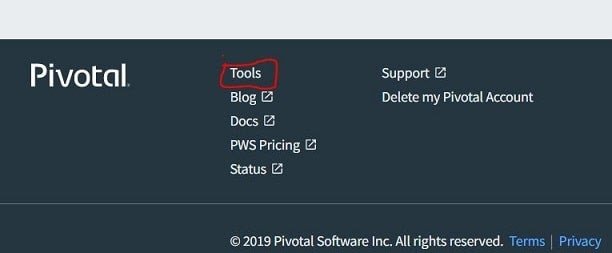
Install cli and cloud foundry instance using login command.
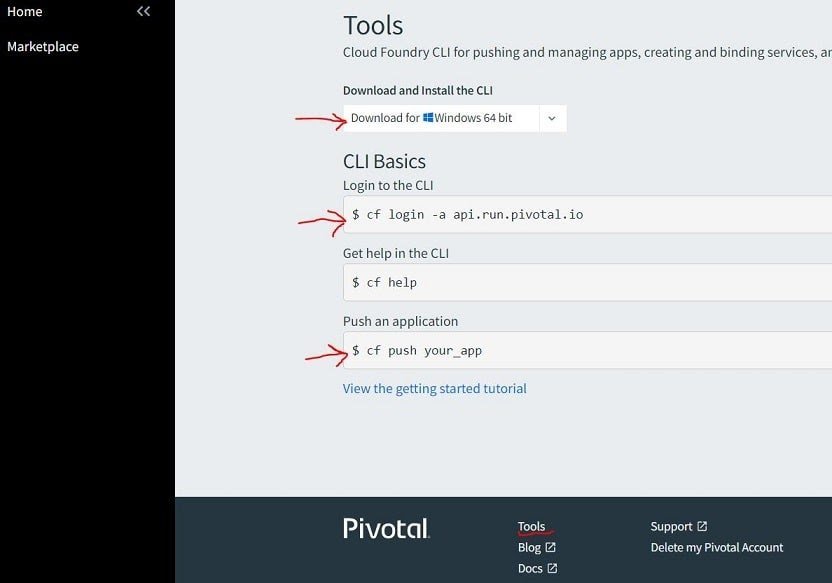
54)What are some basic command in CF?
Ans:
Version :cf — version
Help :cf help
To Login Cloud Foundry (PCF) :cf login – a api.run.pivotal.io
Push an application:cf push app_name
View Organization:cf orgs OR cf org
Space:cf spaces
Create Spaces :cf create-space -o
Stop application:cf stop
Start application:cf start
Restart application:cf restart
View Logs:cf logs
55)In how many ways we can use Pivotal Cloud Foundry?
Ans:
There are various ways to connect to Cloud Foundry.
- Command Line Interface (CLI)
- Web based application management
- Eclipse/STS plugin
56)How memory allocation happens?
Ans:
512 is default memory would get allocate.
Can configure/extend as per project application or production needs
57)Can we use third party log mangers in Cloud Foundry (PCF)?
Ans:
Yes, Cloud Foundry provides provision to use third party managers like Splunk, Logstash, Logenteries, Papertrail etc.
58)What is a Buildpack?
Ans:
Allow cloud foundry to support multiple language and deployment environments.
Buildpacks for Java, Ruby, Javascript etc
Buildpacks for Tomcat, Rails, Node.JS
60)How Cloud Foundry different from AWS?
Ans:
Cloud Foundry is PaaS. Cloud Foundry is open source platform build by Pivotal. Pivotal Cloud Foundry can be deployed on OpenStack, VMware,AWS etc.. Where as AWS is IaaS
61) What is Cloud Foundry container?
Ans:
- A container is a standard software unit that packages code and all its dependencies, so that the program runs from one software environment to another quickly and reliably. Pivotal Cloud Foundry (PCF) is a multi-cloud platform for container, management, deployment and continuous delivery platform.
- Cloud Foundry supports both the developer-built container and the platform-built container. Cloud Foundry allows companies to reap container benefits, support cloud architectures, and continue building a DevOps culture.
62)Is Cloud Foundry a container?
Ans:
Kubernetes is a Container Runtime, where as Cloud Foundry is an Application Runtime.
63)Is Heroku based on Cloud Foundry?
Ans:
To manage application settings and scaling, each use their own ruby gems (vmc and heroku, respectively). Both Cloud Foundry and Heroku are controlled mainly from the command line. Heroku has integrated git into its deployment process, though Cloud Foundry is does not.
64)What Is The Security Aspects Provided With Cloud?
Ans:
- Security is one of the major aspects which come with any application and service used by the user. Companies or organizations remain much more concerned with the security provided with the cloud. There are many levels of security which have to be provided within a cloud environment such as:
- Identity management: it authorizes the application service or hardware component to be used by authorized users.
- Access control: permissions have to be provided to the users so that they can control the access of other users who are entering in the cloud environment.
- Authorization and authentication: provision should be made to allow the authorized and authenticated people only to access and change the applications and data.
65)How cloud services are measured?
Ans:
- Cloud computing provides the services to the organizations so they can run their applications and install them on the cloud. Virtualization is used to deploy the cloud computing models as it provides a hidden layer between the user and the physical layer of the system.
- The cloud services are measured in terms of use. Pay as much as you use that can be on the basis of hours or months or years. Cloud services allow users to pay for only what they use and according to the demand, the charges or the prices gets increased.
66) Do I need a Linux Foundation ID to register for the Certificate exam?
Ans:
Yes, to register for the exam, you will need a Linux Foundation ID. If you do not already have a Linux Foundation ID, apply for one here. You will receive an email with the subject line: “Validate your Linux Foundation ID email.” Once completed, you can log in when prompted with your new Linux Foundation ID credentials.
67)What Is A Cloud Service?
Ans:
- A cloud service is a service that is used to build cloud applications. This service provides the facility of using the cloud application without installing it on the computer.
- It reduces the maintenance and support of the application as compared to those applications that are not developed using the cloud service. The different kinds of users can use the application from the cloud service, which may be public or private application.
68) Explain Hybrid And Community Cloud?
Ans:
- The hybrid cloud consists of multiple service providers. This model integrates various cloud services for Hybrid Web hosting. It is basically a combination of private and public cloud features.
- It is used by the company when a company has requirements for both the private and public clouds. Consider an example when an organization wants to implement the SaaS (Software as a Service) application throughout the company. The implementation requires security that can be provided by the private cloud used inside the firewall.
- The additional security can be provided by the VPN on the requirement. Now, the organization has both private and public cloud features.
- The community cloud provides a number of benefits, such as privacy and security. This model, which is quite expensive, is used when the organizations having common goals and requirements are ready to share the benefits of the cloud service.
69)Mention The Basic Components Of A Server Computer In Cloud Computing?
Ans:
The components used in less expensive client computers matches with the hardware components of a server computer in cloud computing. Although server computers are usually built from higher-grade components than client computers. Basic components include Motherboard, Memory, Processor, Network connection, Hard drives, Video, Power supply, etc.
70)What Does Software As A Service Provider?
Ans:
- Software as Service is another layer of cloud computing, which provides cloud applications like google is doing, it is providing google docs for the user to save their documents on the cloud and create as well.
- It provides the applications to be created on the fly without adding or installing any extra software component. It provides built-in software to create wide varieties of applications and documents and share them with other people online.
71) What Are The Different Modes Of Software As A Service?
Ans:
- Software as a Service provides cloud application platform on which a user can create an application with the tools provided. The modes of software as a service are defined as:
- Simple multi-tenancy: in this, each user has its own resources that are different from other users. It is an inefficient mode where the user has to put more time and money to add more infrastructure if the demand rises in less time to deliver.
- Fine-grain multi-tenancy: in this, the functionality remains the same that the resources can be shared to many. But it is more efficient as the resources are shared not the data and permission within an application.
72)What Do You Understand From Vpn?
Ans:
VPN stands for the virtual private network; it is a private cloud which manages the security of the data during the transport in the cloud environment. VPN allows an organization to make a public network as a private network and use it to transfer files and other resources on a network.
73) What Is The Use Of Eucalyptus In Cloud Computing Environment?
Ans:
- Eucalyptus stands for Elastic Utility Computing Architecture for Linking Your Programs to Useful Systems and provides an open source software infrastructure to implement clusters in the cloud computing platform.
- It is used to build private, public and hybrid clouds. It can also produce your own datacenter into a private cloud and allow you to extend the functionality to many other organizations.
- Eucalyptus provides APIs to be used with the web services to cope up with the demand of resources used in the private clouds.
74) Is it cost-effective to implement a private cloud rather than a public cloud and why?
Ans:
It depends on the type of business that demands a cloud setup. Suppose if the subscription on a public cloud for an application that is to be deployed on OS images is proving to be more costly then to buy some new datacenters and maintain them. Then obviously the private cloud has to be set up instead of a public cloud. This public clouds follow utility billing methodology as an electricity bill for example.
75) What are some open source cloud computing platform databases?
Ans:
- Cloud computing platform has various databases that are in support. The open source databases that are developed to support it is as follows:
- MongoDB: is an open source database system which is schema-free and document-oriented database. It is written in C++ and provides tables and high storage space.
- CouchDB: is an open source database system based on Apache server and used to store the data efficiently.
- LucidDB: is the database made in Java/C++ for data warehousing. It provides features and functionalities to maintain a data warehouse.
76) How User Will Gain From Utility Computing?
Ans:
- Utility computing allows the user to pay per use means whatever they are using only for that they have to pay. It is a plugin that needs to be managed by the organizations on deciding what type of services has to be deployed from the cloud.
- Utility computing allows the user to think and implement the services according to them. Most organizations go for a hybrid strategy that combines internally delivered services that are hosted or outsourced services.
77) How important is the platform as a service?
Ans:
- Platform as a Service is an important layer in cloud architecture. It is built on the infrastructure model, which provides resources like computers, storage, and network. This layer includes organizing and operate the resources provided by the below layer.
- It is also responsible to provide complete virtualization of the infrastructure layer to make it look like a single server and keep it hidden from the outside world.
78)How does cloud computing provides on-demand functionality?
Ans:
Cloud computing is a metaphor used for the internet. It provides on-demand access to virtualized IT resources that can be shared by others or subscribed by you. It provides an easy way to provide configurable resources by taking it from a shared pool. The pool consists of networks, servers, storage, applications, and services.
79)How the users and workspaces are organized by Cloud Foundry?
Ans:
Cloud controller or manager can simply define or gas as well as workspaces within assign roles such as auditor, developer, and admin to every user to organize user access to control resource use and to the cloud. The UAA server simply braces access control and can store the information of user either internally or externally through SAML and LDAP.
80)What do you know about system integrators in Cloud Foundry?
Ans:
These are very useful in providing a game plan of a complex process which is used to design a cloud platform. Integrator enables to build correct private and hybrid cloud network as they are equipped with all the information related to creating data center.
81)What do you know about hosting static files in Cloud Foundry?
Ans:
After creating the account and setting up the command-line interface tool, applications can simply deploy. Generally, static files need a Web server such as Nginx or Apache. The platform undoubtedly takes care of configuration after this and applications can be hosted.
82) How will I, as a developer, benefit from Certification?
Ans:
- Organizations are looking for qualified developers that can be highly productive working on top of the Cloud Foundry platform. Our training program prepares you to work with Cloud Foundry and to understand how cloud-native applications are designed and built. Further,
- certification demonstrates to the many employers looking for qualified developers that you have passed a performance-based knowledge exam and you have the skills they’re looking for, both in terms of conceptual understanding and practical hands-on experience.
83) Is there training to prepare for the Certification exam?
Ans:
Yes! Our Cloud Foundry for Developers eLearning course (or equivalent training from one of our training partners) provides developers with the knowledge necessary to be productive on the Cloud Foundry platform. Applying that knowledge, as well as spending time working with Cloud Foundry in a real-world setting, will prepare developers for the Cloud Foundry Certified Developer exam.
84) Who offers the Certification and administers the exam? Do they offer other certifications?
Ans:
The Cloud Foundry Foundation, in partnership with the Linux Foundation, offers the Certification exam. The Linux Foundation offers three additional certifications: Linux Foundation Certified System Administrator; Linux Foundation Certified Engineer; and Certified OpenStack Administrator.
85)What Is A Cloud?
Ans:
- A cloud is a combination of hardware, networks, storage, services, and interfaces that helps in delivering computing as a service. It has broadly three users which are end-user, business management user, and cloud service, provider.
- The end-user is the one who uses the services provided by the cloud. The business management user in the cloud takes the responsibility of the data and the services provided by the cloud. The cloud service provider is the one who takes care or is responsible for the maintenance of the IT assets of the cloud.
- The cloud acts as a common center for its users to fulfill their computing needs.
86)What are the optimizing strategies used in the cloud?
Ans:
- To optimize the cost and other resources there is a concept of three-data-center which provides backups in cases of disaster recovery and allows you to keep all the data intact in the case of any failure within the system.
- System management can be done more efficiently by carrying out pre-emptive tasks on the services and the processes which are running for the job. Security can be more advanced to allow only limited users to access the services.
87)How To Secure Your Data For Transport In Cloud?
Ans:
Cloud computing provides very good and easy to use the feature to an organization, but at the same time, it brings lots of question that how secure is the data, which has to be transported from one place to another in the cloud. So, to make sure it remains secure when it moves from point A to point B in the cloud, check that there is no data leak with the encryption key implemented with the data you sending.
88)What Are System Integrators?
Ans:
- Systems integrators are an important part of the cloud computing platform. It provides the strategy of the complicated process used to design a cloud platform.
- It includes well-defined architecture to find the resources and the characteristics which have to be included for cloud computing. Integrators plan the user’s cloud strategy implementation.
- Integrators have knowledge about data center creation and also allow more accurate private and hybrid cloud creation.
89) Is There Any Difference In Cloud Computing And Computing For Mobiles?
Ans:
- Mobile cloud computing uses the same concept but it just adds a device of mobile. Cloud computing comes into action when a task or data get kept on the internet rather than individual devices.
- It provides users on-demand access to the data which they have to retrieve. Applications run on the remote server and then given to the user to be able to, store and manage it from the mobile platform.
90)Explain Security management in terms of Cloud Computing?
Ans:
- Identity management access provides the authorization of application services.
- Access control permission is given to the users to have complete controlling access of another user who is entering into the cloud environment.
- Authentication and Authorization provides access to only the authorized and authenticated users only to access the data and applications
91) Why is Virtualization required in implementing the Cloud Foundry?
Ans:
Handling the service level policies is the first thing that demands virtualization in Cloud Foundry. In addition to this, handling cloud operating system is also made easy with virtualization. The most important is virtualization is very useful when it comes to keeping the user level and the backend level concepts different from each other. Moreover, its helps in cutting down the errors that declare their presence time to time.
92)What are Consul and BBS?
Ans:
- Cloud Foundry component VMs communicate with each other internally through HTTP and HTTPS protocols, sharing temporary messages and data stored in two locations:
- A Consul server stores longer-lived control data, such as component IP addresses and distributed locks that prevent components from duplicating actions.
- Diego’s Bulletin Board System (BBS) stores more frequently updated and disposable data such as cell and application status, unallocated work, and heartbeat messages. The BBS stores data in MySQL, using the Go MySQL Driver.
93)What is Metrics Collector?
Ans:
The metrics collector gathers metrics and statistics from the components. Operators can use this information to monitor a Cloud Foundry deployment.
94) What is Diego in CF?
Ans:
Diego is a self-healing container management system that attempts to keep the correct number of instances running in Diego Cells to avoid network failures and crashes. Diego schedules and runs Tasks and Long-Running Processes (LRP).
95) What are the components of Diego architecture?
Ans:
Diego architecture consists of below components:
- Diego Cell Components
- Diego Brain Components
- Database VMs
- Access VMs
- Cloud Controller Bridge Components
- Consul
- App Lifecycle Binaries
96) What is Diego Brain?
Ans:
Diego Brain distribute Tasks and LRPs to Diego Cells and corrects discrepancies between Actual and Desired counts to ensure fault-tolerance and long-term consistency.
97) What is CC-Bridge?
Ans:
The CC-Bridge translate app-specific requests from the Cloud Controller to the BBS.
98)What are the CC-Bridge components?
Ans:
The CC-Bridge components are:
Stager, CC-Uploader, Nsync Bulker, Nsync Listener, TPS Listener, and TPS Watcher.
99)How Diego Balances App Processes?
Ans:
A) Diego balances app processes over the virtual machines (VMs) in a Cloud Foundry (CF) installation using the Diego Auction. When new processes need to be allocated to VMs, the Diego Auction determines which ones should run on which machines. The auction algorithm balances the load on VMs and optimizes app availability and resilience.
100)What are the SSH Components in CF?
Ans:
The Cloud Foundry SSH includes the following central components, they are:
- An implementation of an SSH proxy server.
- A lightweight SSH daemon.


